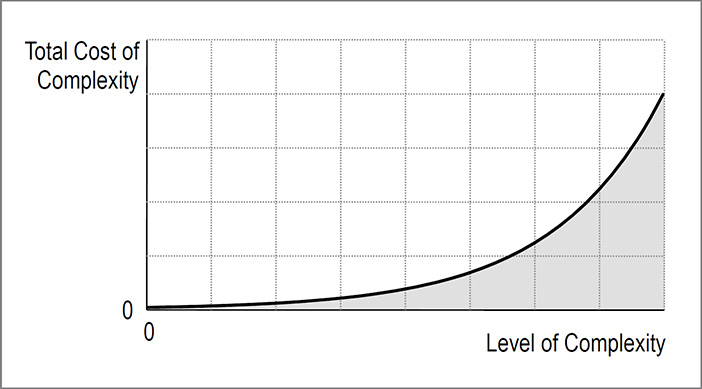INTRODUCTION
The Killer of Scale
“Does a ship sail to its destination no better than a log drifts nowhither? . . . And there you have our difference: to be in hell is to drift: to be in heaven is to steer.”
—GEORGE BERNARD SHAW, MAN AND SUPERMAN, ACT III
“This is what killed our scale!” said the head of strategy, pointing to one of our charts.
We were sitting in a conference room, located on the ground floor of the company’s headquarters. One entire wall was glass, providing a cheery view of the bright skies and corporate campus grounds. Outside there were still traces of a recent snowfall, streaks of white on the landscaped lawn.
It was a familiar scene, the two of us gathered in a boardroom with the head of strategy, the leader of product development, and a gathering of other senior executives. We’d had meetings like this on a regular basis since the publication of our first book, Waging War on Complexity Costs, in 2009.
In that book, we had presented our world view, one that had grown out of our experiences working with clients. Companies, it seemed to us, were struggling with the sheer complexity of their market and their business. In fact, these organizations, and the markets in which they competed, were best described as complex systems, scientific jargon that encapsulated the sheer interconnectedness that was inflating costs, slowing growth, and at the very least suggested very different rules of engagement for companies today. This wasn’t a theoretical construct; we had seen it in dozens of companies, and the book had seemed to touch a nerve.
The head of strategy was pointing to one of our charts, the one that showed the geometric growth of complexity costs (see Figure I.1). “Ten years ago, no one was thinking costs would rise like this. But this is exactly what happened to us. We never got the scale economies we expected. Complexity killed our scale.”

FIGURE I.1: The Geometric Growth of Complexity Costs
His company, a multibillion-dollar technology venture, had seen tremendous growth over the past decade in line with the original business plan and strategy that had attracted plenty of investors in the first place. The strategy had been simple and compelling: the company would build upon its business and technology platforms and in the process attain ever-increasing economies of scale. And that would translate, according to the plan, to annual profits at this point in its journey of $1 billion.
That was the plan. But while the revenues came, the company never realized the scale economies for which it had planned. Its costs continued to rise, and moreover, rise at an increasing pace: the geometric growth of complexity costs. The board had been growing impatient and was now seeking a quick fix to the situation.
For the head of strategy, the penny had dropped, but it didn’t seem to have brightened his mood. He knew a path to profitability meant wrestling with the complexity in his organization.
“I wish I had this chart 10 years ago,” he said.
We thought, and your investors are probably wishing the same. But the meeting got us thinking. How could this happen? Why do companies’ growth strategies so frequently lead them to crash on the rocks? How should companies think about growth in a complex world? Since the publication of Waging War on Complexity Costs, we have focused on answering and expanding upon these questions. But the original spark was that day.
At the end of the meeting, we left the head of strategy with some words of encouragement, and the two of us made our exit out into the chilly mountain air. We were still consumed by what we had heard. The implication had hit us both like a thunderbolt: a group of very smart people had invested more than $10 billion in a business plan that was based on an out-of-date understanding of the world. No one had accounted for the impact of complexity on profitable growth. No one had accounted for how, in today’s complex world, companies needed new rules for attaining and sustaining profitable growth. And it made us wonder: How many other companies are in a similar situation today, about to embark on a growth journey built on shaky foundations?
We were both thinking the same thing. We had another book to write.
A New Framework for Global Growth
For brevity in this book we’ll make two assumptions. The first is a reasonable starting point: that your business has a good set of customers, a portfolio of products and services, dedicated management, and the usual mix of positives and negatives that touch global companies. The second is that your primary interest is in the new and the different. So we’ll be concise with our treatment of traditional elements of growth strategy. We’ll train our eye for the most part on the new knowledge and insights that have emerged around growth and complexity through our research and client work.
At this point in time, the stakes couldn’t be higher. Many companies—including, most likely, your own—are fully engaged in new growth initiatives, and setting sail on a voyage to find scale and profitability. Now is the time to assess your growth strategy! One degree of difference in direction at the outset, a slight shift of emphasis on different disciplines within your business, may be all that determines whether you reach safe harbor or end in a shipwreck.
This book provides a new framework for profitable growth. And while you’ll find plenty of books on growth, this is the first book to address what it means to achieve breakaway growth and profitability in this new age.
In this book, we will prepare you for charting a new course through these dangerous waters. In the chapters that follow we will introduce you to the new landscape, the traps that can lure you onto the rocks, and the tools and perspective you will need to find profitable growth in the Age of Complexity.* Anchors aweigh!
* Age of ComplexitySM is a service mark of Wilson Perumal & Company, Inc.
